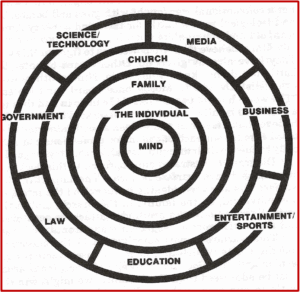
In August 1975, there was a dinner meeting between Loren Cunningham, the founder of Youth With a Mission (YWAM), and Bill Bright, the founder of Campus Crusade for Christ, now known as Cru. The day before, Cunningham was “listening to the Lord,” and God said to him: “I want to give you some classrooms to disciple, to teach, the nations.” He believed God was telling him how to disciple nations. “You do it through the people called into these various spheres.” When Cunningham and Bright met, as Loren was reaching for his paper, Bill said he wanted to share with Loren what God had shown him, “and it was the same, virtually the same list that God had given me the day before.”
In an October 2023 article on the death of Loren Cunningham on Christianity Today, Daniel Silliman added that a few weeks after this meeting, Loren’s wife heard Francis Schaeffer make a similar argument about taking dominion over seven different cultural areas: family, religion, education, media, art, economics, and government. But Cunningham originally saw the spheres as a framework for evangelism and “Great Commission strategies,” not for taking dominion over culture.
Loren Cunningham confirmed these “spheres” were the (1) family, (2) the church, (3) education, (4) media—public communications in all forms (printed and electronic), (5) celebration (arts, entertainment and sports), (6) economy or business, and (7) government. Science was part of economy/business, where “it raises the wealth of the world.” In an aside, Cunningham said according to Isaiah 33:22, the area of government was said to have three branches, the judicial, legislative, and executive. Each of these “groups” or spheres had thousands of subgroups. But he added those spheres could be seen as mountains, “they can be a mountain to achieve for God, or they can be a classroom that you’re going to disciple a nation in.”
Cunningham went on and developed the University of the Nations in YWAM as a consequence of “listening to the Lord.” But it doesn’t appear their conversation inspired Bill Bright the way it did Loren Cunningham. Ten years later Bright coauthored Kingdoms at War: Tactics for Victory in Nine Spiritual War Zones about how biblical influences were being eroded from the foundational structures of our society. Bur he never mentioned this encounter with Loren Cunningham; not even in the acknowledgements for Kingdom at War.
In Kingdoms at War, Bill Bright and Ron Jenson said they thought we were in an ideological war, a warfare of ideas. “The impact of that warfare has an ever-widening influence on the mind, on the individual, on the family, in the church, and in various professions.” And they illustrated this belief in the following diagram of what they called patterns of influence:
There were six “major” professions: science/technology, media, business, entertainment/sports, education, law, and government over the individual family, and church. Bright and Jenson believed that a few dedicated men and women within these professions could “radically influence their disciplines and our country for good.” But this doesn’t sound like what is now known as the 7 Mountains Mandate.
YWAM’s University of the Nations currently operates in 650 locations in 160 countries, with these spheres as key foundational principles. The University of the Nations trains its students to serve in all spheres of society, in all nations. Its goal is to “teach students how to apply biblical truth practically and to fulfill the Great Commission (Matthew 28:18-20).” There is a longer video on the YWAM Podcast Network, “The Seven Spheres of Influence,” where Cunningham shared that the idea behind the spheres was to influence those areas of society with the gospel. It seems he had been “molded” to receive the above vision of the spheres from the time he was a child.
The Christianity Today article said both of Loren Cunningham’s parents were ordained Assembly of God ministers. He learned from his mother that if God had something important to tell you, “He will speak to you directly.” He began hearing God speak to him at the age of six, and this was a regular personal experience by the time he was nine. When he was 13, he felt called to ministry. He eventually had a vision of waves made up of young people crashing on the shores of every continent. This vision would become the core idea for YWAM, Youth With a Mission.
After graduating from Central Bible College, an Assemblies of God school, he began doing youth ministry work in Southern California for the denomination. He had the above vision to launch a youth mission program, but the leadership of the Assemblies of God thought his plans were too complex. “Cunningham decided to leave the Assemblies of God and go out on his own. YWAM was officially incorporated in the state of California in February 1961.”
So, Loren Cunningham had a life-long habit of seeking and receiving visions from God. And when he thought he heard God speak, he listened and tried to follow what he believed God told him. His understanding of what God said to him in August of 1975 was that God wanted him to disciple and teach the nations. Then in 2000, he met with Lance Wallnau and told him about the vision he had 25 years earlier. Wallnau saw the idea’s potential and started leading seminars and training courses that began the transformation of Cunningham’s original vision of spheres of discipleship and evangelism into a template for spiritual warfare in the 21st century.
The Seven Mountain Meme
In The Violent Take It by Force, Matthew Taylor said this story has been told and retold so many times—by Cunningham, Wallnau and others—that it’s “taken on a mythical quality,” with its factual origins hard to discern. This is evident above, where Cunningham said these spheres/groups could be mountains to achieve for God, or they could be classrooms to disciple a nation.
Jeff Fountain, who spent over 40 years with YWAM, agreed with Taylor. Fountain thought Cunningham’s teaching on “the seven spheres” was being distorted. He said over time Cunningham’s original list of six classrooms (church, family, arts and entertainment, media, education and government) became seven when economics was added. He remembered a discussion at YWAM following Cunningham’s telling of his new awareness that missions involved more than just evangelism, that suggested business should be included. Fountain also thought Cunningham’s “classrooms” sounded a lot like the “spheres” of Abraham Kuyper.
Yet as Loren explained his new awareness that missions involved more than just evangelism (a discussion held a year earlier at the first Congress on World Evangelization in Lausanne), he made no reference to the classic Reformed thinking that had transformed Geneva, and shaped countries including Scotland, England and the Netherlands. With his Pentecostal background, Loren was likely unaware of it, I thought. He then described sharing his revelation with Bill Bright of Campus Crusade (now, Cru), who around the same time had had a similar type of epiphany. Bright’s own list of nine ‘zones’ was spelt out a decade later in his book, Kingdoms at War: Tactics for Victory in Nine Spiritual War Zones (the six “major professions, the church, the family and the individual).
As the story was retold, Bill’s list of nine spiritual war zones became “exactly the same” as Loren’s. Francis Schaeffer was also said to be “receiving the same revelation” that summer, when in actuality his [Schaeffer’s] whole theological training had been steeped in Calvinism.
Fountain thought when Cunningham taught about the seven spheres, he was not encouraging others to “storm these mountains” or take them by force. Rather, he believed that Cunningham urged faithful engagement “in the various spheres of life, as salt and light, as yeast, as planted mustard seeds.” Similar to how the early church eventually turned the Roman Empire upside down, our Christian presence would bring life into each sphere. “A bottom-up approach.”
According to Taylor, Wallnau took Cunningham’s account of the seven spheres and combined it with a story he heard from a friend’s near-death-experience. The friend had a vision of seven islands emerging from the ocean, and becoming seven mountains. In the vision God told the man, “Those are seven world kingdoms that shape the world.” Afterwards, the man’s spirit returned to his body, “and he went on to be elected to the Georgia state legislature.”
Taylor said Wallnau would later acknowledge “these ideas of discipling or transforming nations resonated for him because of the Latter Rain theology in which he was already steeped.” Wallnau had known Esther Mallett, who was a major West Coast leader of the Latter Rain movement and founder of Community Chapel World Outreach. He called her his spiritual mother, “and she trained him in the Latter Rain teachings about apostles, prophets, and the end-times movement of God.” In the mid-1990s, he served as a pastor in one of her churches, Word of Life Covenant Church in Cranston, Rhode Island.
There was a significant, but subtle shift in the rhetoric of spheres used by Cunningham to that of mountains used by Wallnau, according to Taylor. Wallnau was not creating, but repackaging older ideas. Cunningham did teach Christians to strategically move into the “spheres of influence.” And he encouraged them to bring Christian leadership to those different spheres/groups in society. “Yet it remained, implicitly, a grassroots approach to cultural change, with influence growing as more and more Christians bore witness to their faith in each sphere.”
Wallnau’s mountain imagery, on the other hand, brought with it a whole new provocation to conquest and strategy for battle. Who will conquer and hold the top of each mountain of culture? Who will govern from the high places? As Wallnau once put it, “There are a remnant of people at the top of each sphere who control power over 90 percent of the influence that happens in their sphere. These people are called ‘kings.’ Jesus says the gospel goes to kings. For some reason, the church focuses on taking the gospel only to the poor and completely forgets about taking it to rulers and world authorities. . . . The key here, if you can capture the high places, you can shape a culture.” If Cunningham imagined transformation from below, growing up through the grassroots, Wallnau proclaimed the need for Christians to assert control of society in a top-down, vanguard maneuver.
This rhetorical shift of imagery began to transform a post millennial theology of cultural spheres for evangelism and discipleship into one of pursuing social transformation through dominion theology. See how Cunningham’s vision was recast in this short video by Salt and Light Council: 7 Mountains of Culture. The seven spheres concept laid dormant outside of YWAM until Lance Wallnau heard about it, and as Taylor said, “put his own spin on it.”
There exists what Taylor described as an Independent Charismatic world, meaning non-denominational churches united by a desire for revival and shared experiences of the spiritual gifts, especially the gift of prophecy. “One of the unifying ideas that also binds this subculture together is the belief that God still speaks through prophecy.” Most of these prophecies never take hold, but a select few become “iconic and supremely influential.” Taylor referred to these as prophetic memes. Like internet memes that are continually refashioned and used in different ways, “They aren’t quite what we would call theological doctrines, in a ’statement of faith’ sense, but they come close in terms of importance.”
The Seven Mountain Mandate is one of the most important prophetic memes in all of global Independent Charismatic Christianity today. It has become the organizing structure for how millions of Christians think about politics and the relationship between the church and the world.
In A New Apostolic Reformation Pivec and Geivett noted where multiple Christian organizations have adopted a toned-down version of the Seven Mountain Mandate, making it difficult to discern whether an organization has embraced the toned-down version or the amped-up NAR version. The toned-down version teaches that Christians must exert influence, not dominion, in these societal spheres or institutions if they are to complete the Great Commission. “It does not teach, however, that workplace apostles must cast out territorial spirits that control these institutions.”
At one extreme of the spectrum are NAR organizations, such as Generals International, led by Cindy Jacobs, which clearly embrace the muscular version. At the other end of the spectrum are those like Campus Crusade for Christ, which appear to embrace a trimmed-down version. The EXCAT stances of other organizations, like YWAM, are more muddled and can’t always be clearly discerned.
For more information on the Seven Mountain Mandate and its significance in the NAR, the Independent Charismatic world, see A New Apostolic Reformation and Reckless Christianity by Holly Pivec and Doug Geivett. Also see “Seven Mountain Mandate” on Holly Pivec’s blog and “The 7 Mountain Mandate vs the Bible,” on the YouTube channel, LongforTruth.
How a Meme Became a Mandate
A sociologist of religion named Paul Djupe, of Denison University, conducted a survey in March of 2023 (twenty three years after the fateful meeting of Cunningham and Wallnau) to estimate how extensive NAR-consistent beliefs are in the American public. He asked respondents if “God wants Christians to stand atop the ‘7 mountains of society,’ including government, education, media, and others,” echoing Wallnau’s mountain metaphor. 20.4 percent of Americans (not just Christian Americans) agreed with the mandate.
He also asked for respondent agreement with the statement, “Modern-day prophets continue to reveal God’s plans for humanity.” 28 percent agree; 37 percent disagree and 35 percent are on the fence. Djupe then asked if modern-day prophets continue to reveal God’s plans to humanity (37 percent disagree; 28 percent agree; and 35 percent are on the fence). And he wondered if others believed if God gives some people the power to heal others through prayer and the ‘laying on of hands’ (34 percent disagree; 36 percent agree; and 30 percent are on the fence). Note that the wording for both items can have a person-centered, not a God-centered meaning. Taylor reflected on the significance of this survey’s results:
In 2000, Lance Wallnau heard Cunningham’s story, blended it with a dubious near-death experience report, and created a charismatic prophetic meme. Today, more than one-fifth of all Americans recognize and endorse that concept. And among prophecy believers, which undoubtedly includes most Independent Charismatics, along with other charismatic-leaning Christians, two thirds share Wallnau’s vision of Christians conquering the high place in society.
See the following table from Djupe’s article.
The catalyst that precipitated this cultural endorsement of these so-called Seven Mountains was when C. Peter Wagner heard Lance Wallnau speak at a prophecy conference in 2001. Wagner recognized Wallnau had a solid, catchy idea (a prophetic meme) and helped him promote it until it became what it is today. See Part 2, as we continue our journey on the road to the Seven Mountain Mandate.







